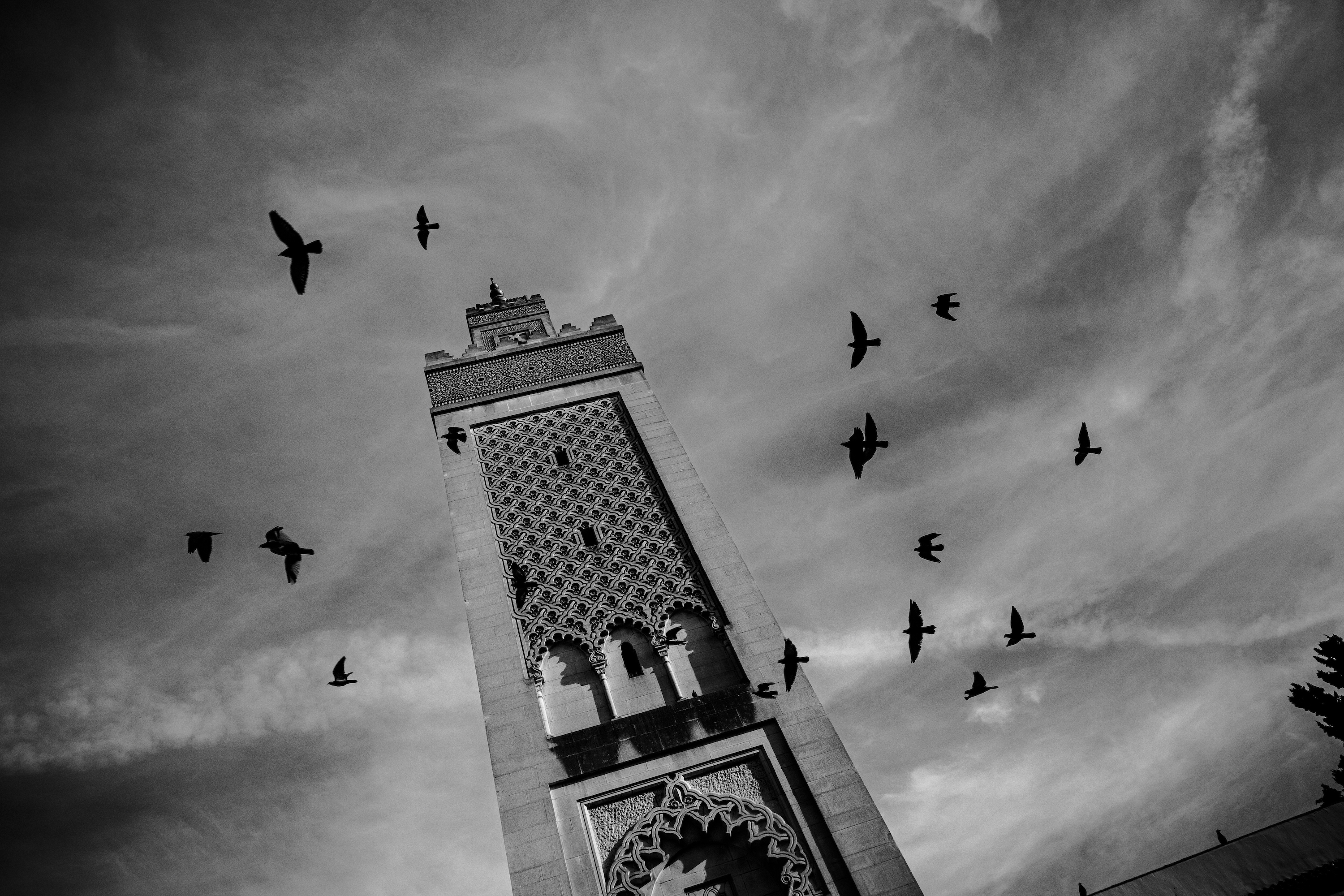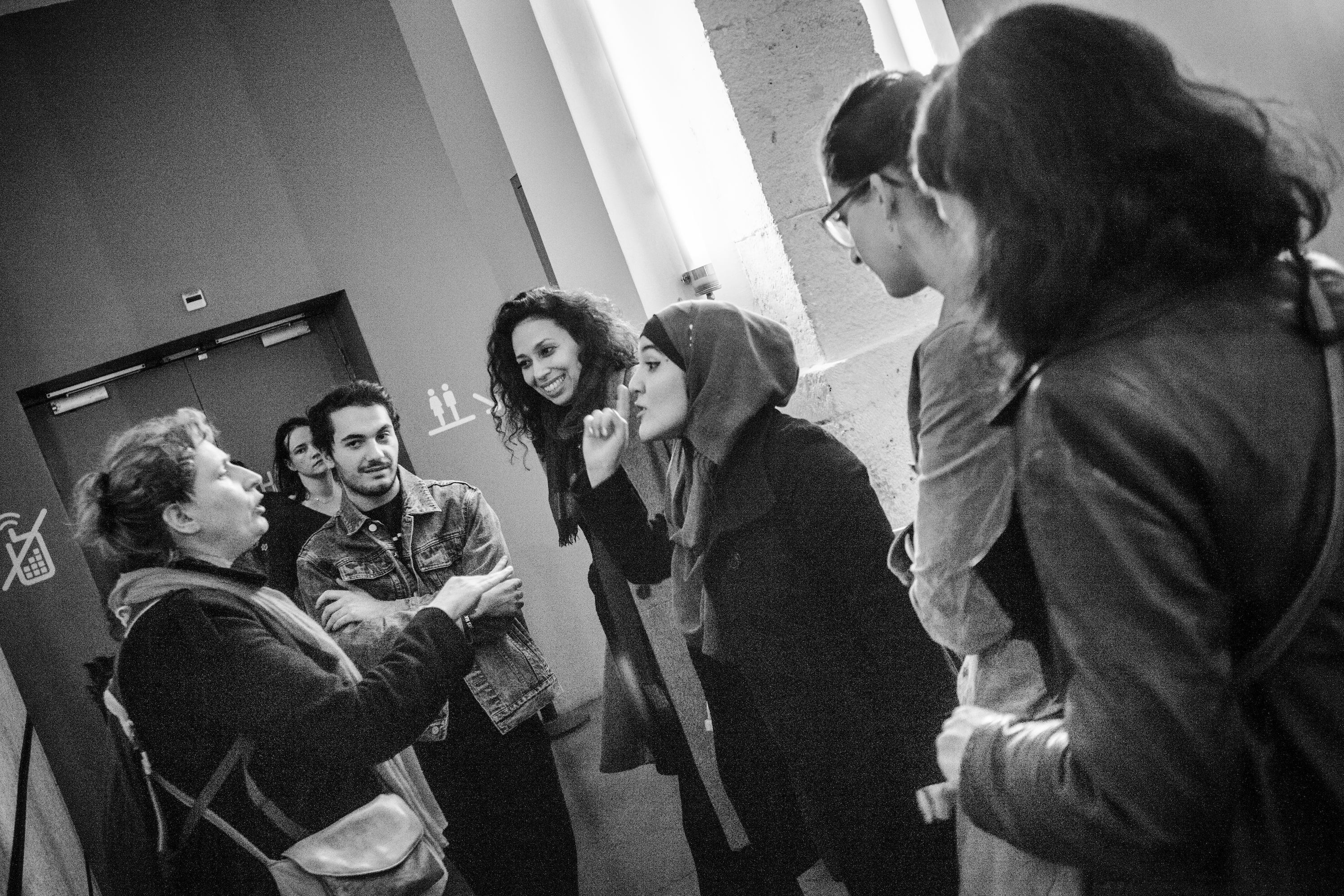Images of the Void
Anthropologist Elayne Oliphant on photographer Oscar B. Castillo's depictions of secular and religious space in Paris.

View of the minaret of the Great Mosque of Paris in France. France has the largest muslim population in Western Europe as well as the highest percentage of Muslims. Their origins vary, but the majority are from Algeria, Tunisia, Morocco and other former french colonies such as Mali. (Photograph by Oscar B. Castillo)
By Elayne Oliphant
The first thing I noticed about Oscar Castillo’s project “The Crescent, The Cross, The Star, The Void” was that it is almost impossible to discern that his photographs were taken in Paris. This takes some doing. Paris is one of the world’s most visited, photographed, and recognizable cities. Yet, while the minaret of the city’s central mosque may be recognizable to some viewers, it’s unlikely that many would connect an image of its Moroccan inspired architecture with the city of light. It is a picture of Muslim French Paris, and thus, not part of the city’s standard image lexicon.
In her book The Republic Unsettled: Muslim French and the Contradictions of Secularism Mayanthi Fernando uses the two terms – Muslim French – as a single phrase in part to demonstrate just how odd the connection still sounds to our ears. While built in 1926, the mosque (see Naomi Davidson’s remarkable history of the space) is difficult to place in the city in part because it is located in a valley. In contrast to the city’s churches, which can easily be spotted across the cityscape, I was always struck by how hard the mosque was to find, its stunning minaret only coming into view in the final steps as one approaches the building.
For Castillo, this moving photo-essay project was precisely such an experiment in re-imagining the French nation. In one of the city’s quieter train stations, “Nation,” Castillo depicts the nation and its people, the people with no nation, and the nation without people. The latter reminded me of Eugène Atget’s photographs of an emptied Paris, its famous streets and passages standing vacant, refusing the imposition of time and context inevitably offered by human subjects. Castillo embarks on this notion of absence in a very different way, however.
The final term he uses to describe his project – the void – is, for Castillo, “that place in the middle that is unknown, rarely discussed, and is under-appreciated. It could be a neutral zone or, even better, an area of convergence and respect, but it is instead a place where we have thrown our fear, intolerance, and ignorance.” He doesn’t use the word “secular,” but coming as it does after the cross, the star, and the crescent, “the void” evokes France’s passionate attachment to the notion of laïcité – a term many insist represents something so wholly non-religious that it cannot be acquainted with others’ mere “secularisms.” Moreover, with these brief sentences, Castillo manages to capture so many of the nuances, critiques, hopes, and failures that accompany the term. By describing the void as that a “neutral zone,” he addresses the secular’s self image, its claims of the “absence” that remains once religion’s intruding influence is removed. By noting, however, that the void is “rarely discussed” and “under-appreciated,” Castillo touches on its normative power, the manner in which its claims to absence may scaffold over the various local idioms, signs, and semiotic ideologies that do what Talal Asad has described as the work of “encouragement” in the reproduction of local norms. And by lamenting how the void has the potential to be “an area of convergence and respect” but remains – ever so stubbornly – “a place where we throw our fear, intolerance, and ignorance” Castillo both recognizes the powerful critiques made against the secular’s insinuative power around the globe, while also holding on to the possibility that it could be something closer to the desires that motivate many of its defenders: that space of “tolerance” where various signs encounter one another on equal ground.
One image I keep returning to is of two women debating. Onlookers surround them; their exaggerated smiles seem to attest to the tension in the space. Is this an image of that abstract public sphere: the space of rational debate and discussion that supposedly sits at the foundation of Enlightened Europe? Passionate advocates of France’s laïcité would insist that young woman’s headscarf disrupts this space, transforming it from a neutral sphere into one of “communalist” tension. Nilüfer Göle, in contrast, would insists that the attempt to create spaces emptied of Islamic signs precisely misunderstands this tradition of abstraction, worrying that the public sphere is at risk of “becoming a place of common sense, of the sacralization of public opinion, and of the contagion of the sensational and the scandalous.”

Nour Boudnaidja, 23 years-old, has a discussion with another woman about the meanings and visions of women emancipation and her idea of freedom and respect as a young French Muslim woman. (Photograph by Oscar B. Castillo)
By attempting to pluralize the French public sphere, Castillo works toward the expansion of the void, without having to efface the subjects who populate it. And yet, as his project continued, some of those subjects requested such an effacement, deciding it was too fraught to include their faces among the tapestry of an increasingly worn and troubled French public sphere. His aspirations for “an area of convergence and respect” seem to vanish as he undoes the photos he had taken. And yet, this re-imaging of a seemingly unfamiliar Paris attests to how, to borrow Göle’s words once again, “the public visibility of religious and cultural signs of Islam expresses the presence of Muslim actors in European countries.” It would be difficult, today, to reproduce Atget’s empty photographs, as a variety of signs push in on the French public sphere. Despite the protests of the Front National, these signs – as Castillo’s photographs demonstrate – populate the nation in ways that cannot be fully undone. Castillo’s “unsettling” (to borrow another phrase from Fernando) project explores, in his words, “how the social fabric is built or destroyed.” And so in them we can see a France in process. We see people the nation has in many ways refused to include within the bounds of Frenchness continuing the painful and incomplete work of imagining themselves within and of it.
***
“Images of the Void” was written by Elayne Oliphant as part of a collaboration between photographer Oscar B. Castillo and journalist Karim Baouz with support from the Magnum Foundation’s “On Religion” project.
For more of this project, see “The Crescent, the Cross, the Star, the Void” by Oscar B. Castillo and “Debate and Turmoil within the ‘French Muslim Community’” by Karim Baouz.
***
Elayne Oliphant’s scholarship explores the privilege of Christianity in France and Europe. She rethinks the evolutionary tale of religious to secular by examining the ongoing (and ever-transforming) dominance of Christian signs and symbols in the public sphere. She has published essays exploring the privileged circulation of Christian signs in contemporary art exhibits, museum displays, and European Court of Human Rights rulings. She is currently completing her first book entitled Signs of an Unmarked Faith: Contemporary Art and Secular Catholicism in 21st Century Paris. Her current research projects include: an examination of the significant role played by real estate, insurance, and financial industries in maintaining the power and privilege of Christian heritage spaces throughout France; and a study of effects of the closure of nine Catholic churches in Manhattan, both on the cityscape and for the city’s Catholic population.
Oscar B. Castillo was born in Caracas, Venezuela in 1981. After studying psychology at Venezuelan Central University the thirst for adventures put him early on the road, meandering for years through many streets all over Europe until photography took him back to formal education in Barcelona – Spain. His professional work as photographer has been geared towards social subjects that promote ideas of solidarity, tolerance and respect and at the time question both the structures of economic and political power and himself as photographer and as part of this society. In his words “I’m not looking to carry on with a militant work, I just aim for the camera to be a coherent extension of my vision of humanity out of photography.”
Oscar has been working for the last years on a long term project about the causes and consequences of violence in his home country and its relationship to the political fracture Venezuela currently endures. His work has been published in TIME Magazine, the New York Times, International New York Times The New Yorker, L.A. Times, Neue Zürcher Zeitung, Foreign Policy, Der Spiegel, L’Internazionale, LFI Leica Magazine, La Vie Magazine, Days Japan and other different major international publications and exhibited in France, Germany, Italy, USA, Spain, Cambodia, Lithuania, Colombia. He is a 2016 Magnum Foundation Grantee for his work about the situation of Islam in France as well as a 2016 winner of Eugene Smith Fellowship. Parallel to his photographic work Oscar developed a passion for teaching, being photography as well an important tool for education, inclusion and social improvement. As instructor and teacher he has been sharing his photographic and social points of view in participatory photographic workshops with kids from excluded communities in Mexico, youngsters in IDPs camps in post-earthquake Haiti or inmates inside Venezuelan prisons. He has also taught in formal educational programs in Colombia, Argentina, Venezuela and elsewhere. Oscar has been participating regularly at Foundry Photo Workshops, first as student in Mexico and India, later as assistant in Argentina and Bosnia, and finally as an instructor in Guatemala.
Karim Baouz was born in Paris in one of the many forgotten ghettos were immigrants have coexisted with — and been excluded by — native French citizens for decades. First a jurist and legal assistant on criminal cases, he turned to journalism and is now a writer and producer of audiovisual content for different a variety of outlets. Baouz’s work is mainly related to the topics of segregation, crime, and extremism where he comes from. His book Plongée au coeur de la fabrique djihadiste analyzes the paths followed by the two young Koachi brothers as they passed from a precarious childhood of abandonment and crime to jail and Islamic radicalization, ending up as the terrorist attackers of the Charlie Hebdo magazine.
